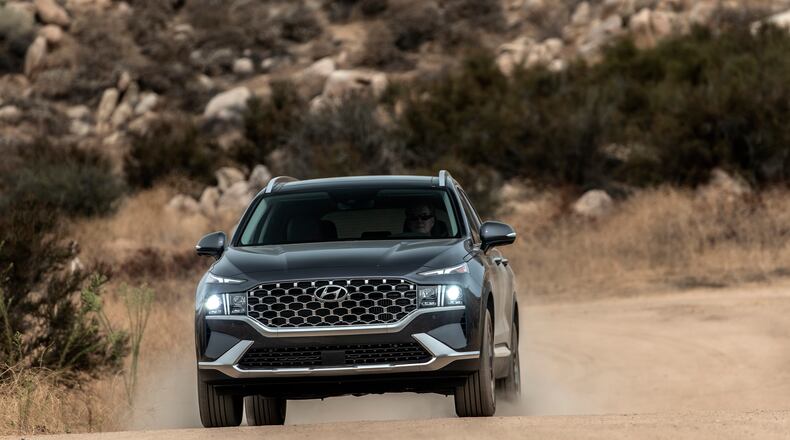Dressed in sultry Calypso Red paint, this top-of-the-line model does a convincing impression of a luxury vehicle. Its seats are trimmed with supple Nappa leather and the headliner and roof pillars are swaddled in a suede-like material. The Calligraphy also comes with a full-color head-up display, premium trim and express up and down rear windows, to name a few of its myriad enhancements. Sure, there are some hard plastics here and there, but the dashboard is mostly soft and there are miles of contrast-color stitching.
This adventurously designed interior is also extremely functional. The physical climate controls and other secondary switches for things like the audio system are super easy to see and reach, mounted on the Santa Fe’s upward-sloping center console. This is also where the push-button shifter lives, which is immediately intuitive. A skosh more storage space up top between the front seats would be nice, but there is an open bin underneath all those switches and knobs, the perfect place to stash a purse or small carry-out order.
Just like the Palisade, comfort is one of the Santa Fe’s strong suits. The Calligraphy model’s front bucket chairs, with their extendable lower cushions, are long-haul cushy, and so is the backseat. Passengers who don’t get to ride shotgun are still coddled by excellent accommodations, as the rear bench’s bottom cushion is a great height above the floor and there’s plenty of headroom and legroom to go around. The Santa Fe’s cargo capacity clocks in at 36.4 cubic feet behind the rear backrests. Fold them down and you get 72.1 cubes of junk-hauling space. That’s more room in each position than you get in a Chevy Blazer or Nissan Murano, though the Ford Edge and Honda Passport are slightly more capacious.
As with passenger comfort and high-quality trimmings, there’s no shortage of available tech in this vehicle. Lower-end models now gain an 8-inch infotainment screen (1 inch larger than before), but fancier variants come with a 10.3-incher that also features embedded navigation. Limited and Calligraphy trims are graced with a 12.3-inch digital instrument cluster, though this is optional on the midrange SEL trim. Apple CarPlay and Android Auto are standard across the range, though counterintuitively, they only connect wirelessly on the Santa Fe’s more basic grades. The up-level infotainment system is easily one of the better offerings available today, being both easy on the eyes and speedy. The user interface is also extremely intuitive and the system promptly responds to inputs, almost never stuttering or lagging. Really, there’s nothing to gripe about here, though the same can’t be said about the drivetrain.
The Santa Fe’s new 2.5-liter turbo-four is a real honey, super smooth and suspiciously silent. It cranks out 277 horsepower and 311 pound-feet of torque, far more of each than either the base engine or the hybrid. This prodigious output gives the vehicle ample acceleration, serious scoot whether you’re taking off from a light or zinging down the highway. Despite this strong performance, the Santa Fe is also quite economical. With available all-wheel drive, this example is estimated to return 21 mpg city, 28 mpg highway and 24 mpg combined, though in mixed, real-world driving I’m getting around 24.5 miles out of each gallon of gasoline, better than the advertised median.
This frugal showing is aided by an eight-speed dual-clutch automatic transmission. It shifts quickly and smoothly once the vehicle is moving, but it’s not all roses. Unfortunately, when starting off, the gearbox feels quite unnatural as it connects the engine to the rest of the driveline. Minor judders are detectable and there are little surges and sags, like it doesn’t respond linearly to throttle inputs. Can we just have the eight-speed torque-converter automatic that comes with the naturally aspirated 2.5-liter engine? Please and thank you.
The Santa Fe’s transmission may be its biggest dynamic weakness, but the rest of this vehicle’s driving experience is pleasant. The interior is incredibly quiet and the ride buttery-smooth. Sure, crisper steering would be nice, as this SUV is anything but sporty, and the brake pedal is on the touchy side, though these are minor complaints.
The Santa Fe offers plenty of advanced driver aids, though several of the most desirable ones are not standard. The base SE model features automatic emergency braking, lane-keeping assist and a driver attention monitor, though you have to step up to the SEL trim to get blind-spot monitoring and rear cross-traffic alert. Naturally, highfalutin Limited and Calligraphy models come with pretty much everything, additional goodies like Remote Parking Assist, lane centering and adaptive cruise control. Hyundai’s implementation of those last two items is among the best in the business. When engaged, the Santa Fe tracks like a monorail, never sawing at the steering wheel or losing track of where it is. The adaptive cruise control is similarly smooth and confidence inspiring, whether you’re in stop-and-go traffic or bombing down the interstate.
Thanks to its upscale interior, over-the-road refinement and avant-garde styling, the new Santa Fe is a screaming deal and an excellent midsize SUV, another home run for Hyundai.
Just like the three-row Palisade, the updated Santa Fe is an excellent all-around SUV, one that offers plenty of features and a near-luxury cabin in Calligraphy trim. You might expect this vehicle to cost a young fortune, but this is absolutely not the case. A base SE model, sans any extras, checks out for around $28,185 including destination fees, which are $1,185. But even the top-shelf example shown here is still an excellent value. As it sits, my tester stickers for $43,440 with just one option padding the bottom line, a $155 upcharge for carpeted floor mats.
About the Author

